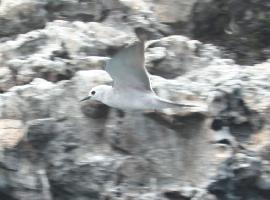
Stav ohrožení
| Ohrožen |
Popis zvířete
The Lesser Crested Tern (Thalasseus bengalensis), a member of the tern family, is a medium-sized seabird known for its graceful flight and distinctive appearance. This bird species exhibits a blend of elegant white and soft grey plumage, accented with striking black markings, that makes it a sight to behold in its natural coastal habitats.Adult Lesser Crested Terns are characterized by their sleek, streamlined bodies that measure between 41 to 45 centimeters in length, with a wingspan ranging approximately from 90 to 100 centimeters. They possess a slender, pointed bill that is vividly colored in a bright orange or yellow, contrasting sharply with their pale plumage. One of the most distinctive features of these birds is their black cap, which extends from the bill over the top of the head and down to the nape, creating a sharp demarcation against the white cheeks and throat.
During the breeding season, the Lesser Crested Tern's black cap is more pronounced, and they develop a slight crest at the back of their head, which is less prominent than that of their close relative, the Greater Crested Tern (Thalasseus bergii). The back and the upper wings of the Lesser Crested Tern are a soft grey, providing a subtle contrast to the white underparts and tail. The legs and feet are black, adding to their striking appearance.
Lesser Crested Terns are highly sociable birds, often found in large colonies during the breeding season. They are known to nest on sandy or rocky islands, beaches, and sometimes on the flat roofs of buildings near the coast. Their nests are simple scrapes in the ground, into which they lay one to three eggs. Both parents share the responsibility of incubating the eggs and feeding the chicks.
These terns are formidable flyers, capable of covering long distances over the ocean in search of food. Their diet primarily consists of small fish, which they catch by performing elegant dives into the water from considerable heights. Occasionally, they may also feed on crustaceans and insects.
Lesser Crested Terns have a wide geographic range, breeding along the coasts of the northern Indian Ocean, the Red Sea, and the Atlantic coast of Africa. During the non-breeding season, they migrate southwards, reaching as far as the southern Indian Ocean and the eastern coast of Africa.
Despite facing threats from habitat destruction, human disturbance, and predation by invasive species, the Lesser Crested Tern is currently classified as Least Concern by the International Union for Conservation of Nature (IUCN), indicating that it is not presently at immediate risk of widespread decline. However, continued monitoring and conservation efforts are essential to ensure that this beautiful seabird can continue to grace our oceans and coastlines for generations to come.
Podobná zvířata
Nové fotografie zvířat
Top 10 zvířat
- Dolphin gull (Leucophaeus scoresbii)
- Diana monkey (Cercopithecus diana)
- Moustached guenon (Cercopithecus cephus)
- Galápagos tortoise (Geochelone nigra complex)
- Australian box jelly (Chironex fleckeri)
- Giant african land snail (Lissachatina fulica)
- Russian tortoise (Testudo horsfieldii)
- Common house mosquito (Culex pipiens)
- Greek tortoise (Testudo graeca)
- Japanese macaque (Macaca fuscata)


